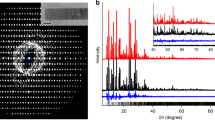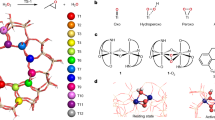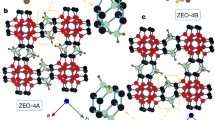Abstract
Physico-chemical characterization of the high-silica zeolite catalyst SSZ-74 (ref. 1) suggested that it, like the related materials TNU-9 (ref. 2) and IM-5 (ref. 3), has a multidimensional 10-ring channel system4. Such pore systems are ideal for many petrochemical applications, and indeed SSZ-74 has been shown to be a good catalyst for a wide variety of reactions1. The elucidation of its framework structure, however, proved to be difficult. Comparable problems were encountered with TNU-9 and IM-5, which were synthesized with related structure-directing agents. Their framework structures, which are the two most complex ones known, both have 24 Si atoms in the asymmetric unit, and were finally solved by combining high-resolution powder diffraction data with information derived from high-resolution electron microscopy images5,6. Therefore, a similar approach, using the powder charge-flipping algorithm7 to combine the two types of data and molecular modelling to help to locate the structure-directing agent, was applied to SSZ-74. This procedure eventually revealed a most unusual 23-Si-atom framework structure (|(C16H34N2)4|[Si92□4O184(OH)8]) with ordered Si vacancies.
This is a preview of subscription content, access via your institution
Access options
Subscribe to this journal
Receive 12 print issues and online access
$259.00 per year
only $21.58 per issue
Buy this article
- Purchase on Springer Link
- Instant access to full article PDF
Prices may be subject to local taxes which are calculated during checkout




Similar content being viewed by others
References
Zones, S. I., Burton, A. W. & Ong, K. Molecular sieve SSZ-74 composition of matter and synthesis thereof. International Patent WO/2007/079038 (2007).
Hong, S. B. et al. Synthesis, structure solution, characterization, and catalytic properties of TNU-10: A high-silica zeolite with the STI topology. J. Am. Chem. Soc. 126, 5817–5826 (2004).
Benazzi, E., Guth, J. L. & Rouleau, L. IM-5 zeolite, method of preparation and catalytic applications thereof. Patent Cooperation Treaty WO 98/17581 (1998).
Burton, A. W. et al. A comparative study of three closely related unsolved zeolite structures. Studies Surf. Sci. Catal. 170, 690–697 (2007).
Gramm, F. et al. Complex zeolite structure solved by combining powder diffraction and electron microscopy. Nature 444, 79–81 (2006).
Baerlocher, Ch. et al. Structure of the polycrystalline zeolite catalyst IM-5 solved by enhanced charge flipping. Science 315, 1113–1116 (2007).
Baerlocher, Ch., McCusker, L. B. & Palatinus, L. Charge flipping combined with histogram matching to solve complex crystal structures from powder diffraction data. Z. Kristallogr. 222, 47–53 (2007).
Baerlocher, Ch., McCusker, L. B. & Olson, D. H. Atlas of Zeolite Framework Types 6th edn (Elsevier, Amsterdam, 2007).
Hong, S. B. et al. Synthesis, crystal structure, characterization, and catalytic properties of TNU-9. J. Am. Chem. Soc. 129, 10870–10885 (2007).
Serra, J. M., Guillon, E. & Corma, A. A rational design of alkyl-aromatics dealkylation-transalkylation catalysts using C8 and C9 alkyl-aromatics as reactants. J. Catal. 227, 459–469 (2004).
Zones, S. I. et al. Indirect assessment of unknown zeolite structures through inference from zeolite synthesis comparisons coupled with adsorption and catalytic selectivity studies. J. Catal. 250, 41–54 (2007).
Grosse-Kunstleve, R. W., McCusker, L. B. & Baerlocher, Ch. Powder diffraction data and crystal chemical information combined in an automated structure determination procedure for zeolites. J. Appl. Crystallogr. 30, 985–995 (1997).
Falcioni, M. & Deem, M. W. A biased Monte Carlo scheme for zeolite structure solution. J. Chem. Phys. 110, 1754–1766 (1999).
Oszlányi, G. & Sütő, A. Ab initio structure solution by charge flipping. Acta Crystallogr. A 60, 134–141 (2004).
Oszlányi, G. & Sütő, A. Ab initio structure solution by charge flipping. II. Use of weak reflections. Acta Crystallogr. A 61, 147–152 (2005).
Wu, J. S., Leinenweber, K., Spence, J. C. H. & O’Keeffe, M. Ab initio phasing of X-ray powder diffraction patterns by charge flipping. Nature Mater. 5, 647–652 (2006).
Zhang, K. Y. J. & Main, P. Histogram matching as a new density modification technique for phase refinement and extension of protein molecules. Acta Crystallogr. A 46, 41–46 (1990).
Palatinus, L. & Chapuis, G. Superflip—a computer program for the solution of crystal structures by charge flipping in arbitrary dimensions. J. Appl. Crystallogr. 40, 786–790 (2007).
Hovmöller, S. CRISP: Crystallographic image processing on a personal computer. Ultramicroscopy 41, 121–135 (1992).
Brenner, S., McCusker, L. B. & Baerlocher, Ch. Using a structure envelope to facilitate structure solution from powder diffraction data. J. Appl. Crystallogr. 30, 1167–1172 (1997).
Brenner, S., McCusker, L. B. & Baerlocher, Ch. The application of structure envelopes in structure determination from powder diffraction data. J. Appl. Crystallogr. 35, 243–252 (2002).
Burton, A. W., Lee, G. S. & Zones, S. I. Phase selectivity in the syntheses of cage-based zeolite structures: An investigation of thermodynamic interactions between zeolite hosts and structure directing agents by molecular modeling. Microporous Mesoporous Mater. 90, 129–144 (2006).
Lewis, D. W., Freeman, C. M. & Catlow, C. R. A. Predicting the templating ability of organic additives for the synthesis of microporous materials. J. Phys. Chem. 99, 11194–11202 (1995).
Engelhardt, G. & Michel, D. High-Resolution Solid-State NMR of Silicates and Zeolites (Wiley, Chichester, 1987).
Koller, H., Lobo, R. F., Burkett, S. L. & Davis, M. E. SiO−⋯HOSi hydrogen bonds in as-synthesized high-silica zeolites. J. Phys. Chem. 99, 12588–12596 (1995).
Oszlányi, G. & Sütő, A. The charge flipping algorithm. Acta Crystallogr. A 64, 123–134 (2008).
Acknowledgements
We thank the beamline scientists at Beamline X16C at the National Synchrotron Light Source, Brookhaven, and at the Swiss Norwegian Beamlines at the European Synchrotron Radiation Facility, Grenoble, for their assistance with the powder diffraction measurements. Research was carried out in part at the National Synchrotron Light Source, Brookhaven National Laboratory, which is supported by the US Department of Energy, Division of Materials Sciences and Division of Chemical Sciences. The NMR facility at Caltech was supported by the National Science Foundation (NSF) under Grant Number 9724240 and partially supported by the MRSEC Program of the NSF under Award Number DMR-0520565. Funding from the Swiss National Science Foundation (C.B., D.X. and L.B.M.) is gratefully acknowledged.
Author information
Authors and Affiliations
Contributions
C.B., D.X. and L.B.M. carried out the structure analysis, S.-J.H. the MAS NMR analysis, I.Y.C. the electron microscopy experiments, K.O. the initial powder diffraction data collection and analysis and S.I.Z. the synthesis of the material. A.W.B. carried out the molecular modelling and coordinated the project.
Corresponding author
Supplementary information
Rights and permissions
About this article
Cite this article
Baerlocher, C., Xie, D., McCusker, L. et al. Ordered silicon vacancies in the framework structure of the zeolite catalyst SSZ-74. Nature Mater 7, 631–635 (2008). https://doi.org/10.1038/nmat2228
Received:
Accepted:
Published:
Issue Date:
DOI: https://doi.org/10.1038/nmat2228
This article is cited by
-
Synthesis strategies and design principles for nanosized and hierarchical zeolites
Nature Synthesis (2022)
-
Ordered absences observed in porous framework materials
Nature (2020)
-
Design and synthesis of polyoxometalate-framework materials from cluster precursors
Nature Reviews Materials (2017)
-
A zeolite family with expanding structural complexity and embedded isoreticular structures
Nature (2015)
-
A family of zeolites with controlled pore size prepared using a top-down method
Nature Chemistry (2013)



